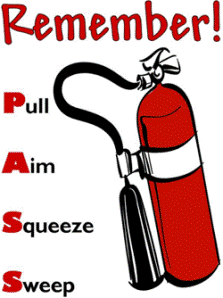 A major part of any property’s fire safety is its fire protection equipment. From smoke detectors and fire alarms through to emergency exits and lighting, the ability to prevent, warn against and combat a blaze is vital to the health and safety of the building.
A major part of any property’s fire safety is its fire protection equipment. From smoke detectors and fire alarms through to emergency exits and lighting, the ability to prevent, warn against and combat a blaze is vital to the health and safety of the building.
Perhaps the most important pieces of equipment in respect to fighting (small) fires are the fire extinguishers that should be situated around the premises in accordance with common business regulations.
However, simply having a fire extinguisher to hand is irrelevant if you or your staff don’t have the knowledge to operate them correctly. Whether you are an adult or want to teach a child about fire safety, this is where PASS comes is.
PASS
As with a lot of health and safety procedures, PASS utilises an easy-to-remember acronym to help prompt uses towards correct extinguisher practice.
Before using an extinguisher, it is vitally important to ensure that you are using the correct model for the type of fire at hand. For example, a water fire extinguisher should never be used on an electric or oil-based fire. Similarly, extinguishers should only ever be used on a small blaze. Anything else will require the immediate attention of the fire authorities.
P = Pull
When first encountering a small fire, check that the extinguisher at hand is suitable for use before attempting to tackle it. Begin by pulling the pin out - this unlocks the extinguisher ready for use. The pin will usually have an inspection tag attached to it, detailing whether or not the unit has passed the testing required for safe usage.
A = Aim
This step is fairly self-explanatory. Take aim by pointing the extinguisher at the base of the fire – some may have a hose nozzle attached that allows for more accurate positioning. Aiming at the base will tackle whatever’s fuelling the fire instead of merely the flames.
S = Squeeze
After carefully aiming, squeeze the handle and spray the source of the fire. Continue to spray until extinguished, bearing in mind that most units will only hold 10-30 seconds of water/foam/wet chemical/dry powder materials.
S = Sweep
While squeezing, sweep the stream backwards and forwards across the base of the fire, beginning from a safe distance and advancing slowly as it reduces in severity.
Following the four basic principles outlined above should be sufficient when tackling the majority of small fires. Remember: always ensure that the correct fire extinguisher is used on the fire type in question. As part of your building’s fire risk assessment, the extinguisher most suited to the environment must be installed in each area.
This article was provided by AAI Security Systems, who provide advice and assistance regarding the extinguisher best suited to the needs of your environment. Our extinguisher range includes foam, CO2, water, powder and wet chemical extinguishers, with automatic models also available.

Recent Comments
In addition to the personal hardship and loss...
No one will know the answer to this...
Bad drivers don't have to ruin your day...
Healthcare workers face a number of serious safety...
In my experience, truck drivers are treated with...